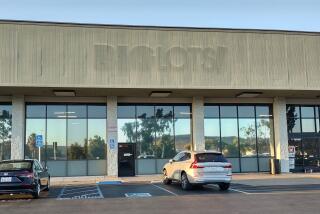Remainder of S&L;’s Loans Termed ‘Dirt’ : * Banking: Regulators aren’t sure of the price of liquidating Great American, but it is probable the costs will be staggering.
- Share via
Federal regulators on Monday declined to estimate what the ultimate cost of liquidating Great American Bank will be to taxpayers, saying the process may take another year or more to complete.
At a press briefing Monday, the thrift’s managing agent J. Michael Berry, who was installed at Great American by the Resolution Trust Corp. last August after federal regulators seized the capital-deficient savings and loan, said, “Obviously there will be a loss to the taxpayers.
“The bottom line is that liabilities will exceed assets,” Berry said. “Where the (loss) will end up is anybody’s guess.”
What seems probable is that the liquidation cost will be staggering. Of the $5.3 billion in assets remaining at Great American, more than $3.2 billion, or 60% of the total, are now classified as “in-substance foreclosures,” loans that the lender has given up hope of being paid and will be costly to dispose of.
That percentage is extraordinarily high in part because Great American’s good assets largely have been sold off over the past year and a half, leaving the once powerful financial institution with a pot of “dirt,” as Berry described the remaining loans.
Berry said Great American has been in a “self-liquidating” mode ever since the seizure, that assets and employees have shrunk over the last five months from $8.6 billion and 1,405 workers to the current $5.3 billion and 1,055 employees. The thrift’s 325 remaining San Diego employees are basically “working themselves out of a job,” he said.
The self-liquidation process was effectively put in motion long before the seizure, however, when the thrift announced in July, 1989, that it was selling all 130 of its California branches to Wells Fargo in a bid to bolster its flagging capital position and save itself.
But losses continued, and, despite the branches’ $491 million sale price, the desperate survival bid failed. For the past five months, Berry and other managers installed by the RTC have been selling off the failed thrift’s relatively good assets, mainly $2 billion in packaged or “securitized” mortgage loans.
Because the asset sales have produced some gains, Great American actually posted profits for its third and fourth quarters in fiscal 1991. Its net worth was still a positive $54 million at year’s end, Berry said.
That net worth was boosted, Berry pointed out, by an “accounting transaction” connected to the wiping out of about $100 million in subordinated bond debt resulting from the takeover. Shortly after the seizure, investors holding those Great American bonds were left with worthless pieces of paper.
But the dirty work is now beginning in earnest at Great American. Except for its remaining 81 branches in Arizona, Washington and Colorado, a network that Berry described as “highly marketable,” Great American has no more good assets to sell. What remains is the “dirt”: the loans and foreclosed properties that nobody wants and whose disposal will result in large losses.
“We get down to the dirt pretty fast,” said Berry, who came to Great American from similar custodianships at failed Santa Barbara Savings and Mercury Savings. “The good assets are out the door. We’ve got the tough assets to sell.”
But Berry declined to say how much the losses will total or whether the failure of Great American will rank alongside those of Lincoln Savings and Imperial Savings in terms of taxpayer costs.
Although the 81 branches are valuable assets, Berry said Great American has not yet been able to sell them because it must “stand in line” to find a buyer until previously-seized thrifts have completed their branch sales, he said.
Just when Great American expects to sell the remaining branches is “not our call,” though Barry said he has set a March 31, 1993, target date for completion of all Great American asset sales.
More to Read
Inside the business of entertainment
The Wide Shot brings you news, analysis and insights on everything from streaming wars to production — and what it all means for the future.
You may occasionally receive promotional content from the Los Angeles Times.










